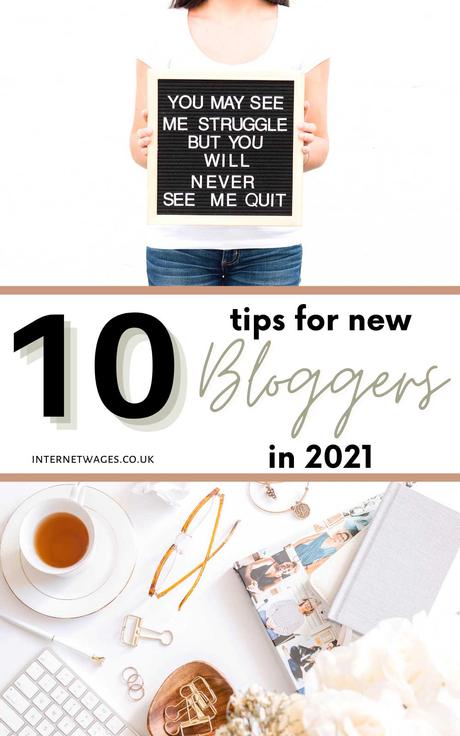So, you’re thinking of starting a blog in 2021? Great! This blog post features 10 tips for new bloggers in 2021 to help you on your blogging journey! It’s definitely not too late to start a blog, whether you want to build a profitable side hustle for yourself, improve your writing skills, or blog for fun!
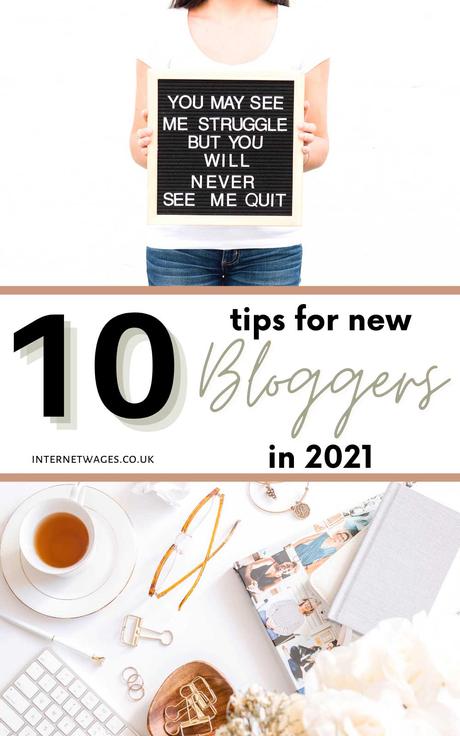
I’ve been blogging for over 7 years now, and like most bloggers, I’ve made quite a few mistakes along the way. Today I’ll be sharing 10 tips for new bloggers in 2021, covering everything from techy stuff to making blogging easier.
1. Use WordPress.org from the beginning
Unless you know you’ll always want to blog as a hobby, you really should set up a WordPress.org self-hosted website. Of course, you can earn money from a WordPress.com, Squarespace, Blogger or Wix website, but WordPress.org is undeniably the king of blogging platforms.
It can seem scary at first, and you will need to learn how to use it, but once you get into the swing of things, you’ll be fine! If you need any guidance, I recommend checking out WPBeginner. For any technical issues, your host should be able to help you. Make sure to back up your blog regularly (this can be automated) in case anything goes wrong.
Step 1: Buy a Domain
Firstly, you’ll need to buy a domain, after thinking carefully about the name. You don’t want to be stuck with a website name about poetry if you plan to expand your content into lifestyle blogging for example. Many bloggers use their full name or a pseudonym for their blog, or alternatively, you could choose a descriptive URL with keywords relating to your content. It’s up to you!
I recommend Namecheap for purchasing domains, I transferred to them a while back after realising that GoDaddy was charging me way too much for my domain renewals. At Namecheap, you can get domains from $1.37.
Step 2: Choose a Host
Then you’ll need to decide on your hosting platform. I personally recommend Lyrical Host, because their service is catered to bloggers, and they provide excellent customer service. A member of their team helped fix my blog on Christmas Day! Plus with Lyrical Host, you get access to a lovely Facebook community and a bunch of freebies (ebooks, stock photos, blog post ideas, tips for speeding up your site etc). My main blog is hosted on Lyrical Host at £9.99 per month, and I will be moving this one over there too when it’s time to renew.
Alternatively, the cheapest option for WordPress blog hosting in 2021 is BlueHost. If you’re just starting out with blogging, you can always take advantage of their discounted first year of hosting ($2.95 per month). You’re free to move to another host at the end of the year if you like!
Step 3: Install WordPress!
Finally, follow the steps for installing WordPress (it’s free), or your host may provide this service for you.
You can use your own domain on WordPress.com instead if you prefer, but it has fewer features than a self-hosted WordPress.org blog. You could migrate a blog from Blogger or WordPress.com to WordPress.org if you want to, but starting out self-hosted from the get-go will save the hassle of migration! Plus the sooner you get a domain for your blog, the sooner you’ll start building up your Domain Authority (DA).
2. Your theme isn’t all about aesthetics
Pick an aesthetically pleasing and functional WordPress theme. Make sure to consider whether your theme is optimised for SEO, includes all the features you need, and loads quickly.
More people than ever are using mobile devices and tablets to visit websites. You need to make sure your theme works properly on mobile as well as desktop.
I don’t even want to think about how much money I’ve wasted on WordPress themes that were too clunky and just didn’t work well for me. Site speed, accessibility and user experience are more important than a pretty design. Try to find a theme that gives you both!
Have a read of my post featuring my favorite free and paid WordPress themes. On this blog, I’m using Kylee More by Studio Mommy and on my main blog, I use Jellybean by Little Theme Shop.
3. Don’t Stress About Getting No Traffic!
We all start somewhere, and you really can’t expect to get a lot of blog traffic (if any) when you start a blog. Unless you have a social media following or a mailing list, who will find your blog? Google takes a while to index your blog posts, and they won’t rank highly in search positions if your blog is brand new.
It takes time. You’ll get there!
When your blog is brand new, focus on publishing good content that you’re happy with, and research keywords for SEO (but don’t stress about it too much, the priority is your writing).
Make sure to sign up to Google Analytics and Google Search Console, they’re really important for tracking your stats and making sure that Google can crawl your content.
4. Pinterest is your friend
While you’re waiting for Google to pick up your blog posts, it’s definitely worth getting to grips with Pinterest.
You might already use Pinterest personally, in which case you’ll know how the platform works. For your blog, unless you’re already pinning highly relevant content to your boards, I recommend setting up a new Pinterest account. Optimise your bio with relevant keywords and create a few boards relating to what your blog is all about!
Make sure to create a Business account on Pinterest, and claim your domain on there. This means you’ll be able to track the analytics and any pins created (including saved pins by other people) that link to your website will be attributed to you.
Pinterest can be an absolute headache, especially with their recent algorithm changes in 2020. You might not get many views or clicks at the beginning, but it’s important to know that a pin could go viral at any time. I still get blog views from pins I made back in 2017!
If you need more advice and a strategy for Pinterest marketing, the ebook I recommend is Big Pin Energy. I followed this at the beginning of 2020, and managed to increase my blog views by 800% and gain nearly 6000 Pinterest followers. At the moment, I’m reaching between 800,000 and 1 million monthly impressions on my main Pinterest account.
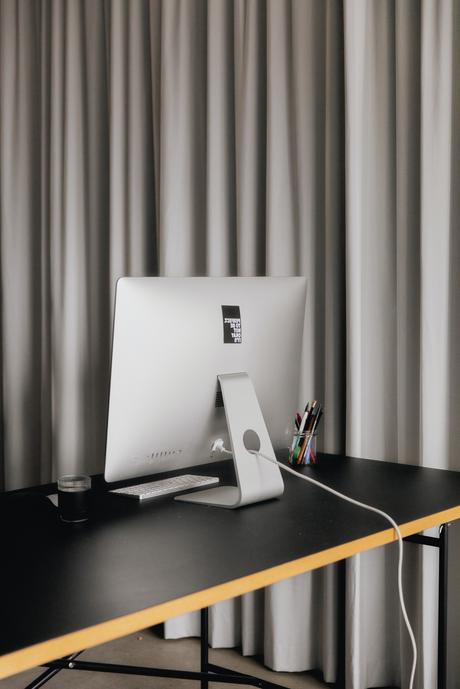
5. Canva is also your friend!
I use a combination of Canva Pro, Photoshop, Procreate, and Adobe Spark for all of my graphics. If you don’t understand Photoshop, Canva is incredibly easy to use.
I spent a lot of time creating pins on Photoshop, but now I just use Canva and Adobe Spark for them, and Photoshop for more complicated stuff.
Canva has so many free templates for social media graphics, including tons of pin templates. I use the pro version because it gives you a lot more stock photos and design elements, but the free version is also excellent.
If you’re into fonts, I’ve got a post all about my favorite free script fonts on Canva.
If you want to take Canva to the next level, you can purchase templates from creators too. There’s no need to go on a spending spree and buy all the pin templates from every blogger you like, but they can be a time-saver instead of creating your own designs.
I use Entrepreneur Templates for my Canva templates and haven’t needed to purchase or design any other templates since I joined. They provide a huge catalog of professionally designed templates for social media, blogs, podcasts, emails, and even ebooks.
6. Comparing yourself with other bloggers is literally a waste of time
Repeat after me:
Comparing myself to other bloggers is a waste of my time.
Especially if that blogger has been writing for 10 years and it’s their full-time job, oh and their partner is a professional photographer! Come on. Their journey is completely different to yours.
Trust me, I’ve been there. In awe of the sheer quantity of content that some bloggers produce, while I’ve struggled to publish four posts in a month. We’re not the same. Focusing on other people is a hindrance to you and your mental health.
Remember that they started somewhere too, with no blog views and hardly any content. I started blogging as a teenager, so you can only imagine the amount of posts I’ve had to go back and improve or delete!
7. Don’t Be Afraid To Promote Your Work
It can feel so awkward to self-promote, especially if you’re more introverted like myself.
I still sometimes struggle with this, and tend to focus more on Pinterest and SEO than Twitter or Facebook.
I think the key point to remind yourself is that if people don’t want to see your content, they wouldn’t follow you.
I’m absolutely guilty of writing a blog post, sharing it on Twitter once, then never sharing it again. If you want to get views, you’ve gotta share it more than once. The lifespan of a tweet is only around 18 minutes. An Instagram story disappears after 24 hours. Most of your followers probably haven’t seen your post, so you need to share it more than once.
You can read more tips in my blog post about promoting your blog on social media. It’s an older one on my other blog, but it’s still relevant.
8. Figure out who your target audience is.
Okay, I’ve just emphasised that sharing your blog posts on social media is important, especially if you’re not ranking on Google yet. But there’s no point mindlessly posting links without knowing who you’re targeting.
Does your target audience even use Twitter? Or do they hang out on TikTok? Figure out who your content is for, and then think about how to best reach them. Experiment and see what works well for you.
Find other bloggers who write content for the same demographic or niche. How do they promote their work? Connect with them!
9. It’s Never Too Early To Start Monetising
This one only applies if you want to monetise your blog. Not everyone does, and I understand that. For me, it’s a big part of my income, and even in my worst months, my blog is profitable. It took a few years to get there, and I don’t make a full-time wage from my blog alone – but I like that it’s a side hustle and a hobby for me.
Anyway, I see questions all the time on social media and Quora asking about when they should start monetising, how many views you should have first etc.
My advice is: start with affiliate marketing. If you’ve written a product review, recommended some books, or shared a round-up post of things you like, there’s no harm in adding affiliate links. You never know when you’ll make a sale! For expert advice on affiliate marketing, check out Reinventing Neesha’s ebook. I’ve learned so much about affiliate marketing from her, she’s truly a pro. You can also get 30% off with the code ’emilyunderworld’.
If you want to monetise with display ads (e.g. Adsense), it’s not really worth doing unless you get a substantial amount of views each month. Ads slow down your website, and you won’t earn very much to start with. Higher-paying ad networks have monthly view requirements, like Mediavine and Ezoic. I use Ezoic on my other blog and needed to reach 10,000 views per month to qualify. I earn less than $100 monthly from the adverts on my blog and have around 30,000 sessions each month. You won’t make big money until you have big views.
Alternatively, you could create your own product to sell. Here are some digital product ideas to help you get started. Have a read of 27 ways to make money blogging for more monetisation options!
10. Writer’s Block Happens To All Of Us
If you’re struggling to come up with content ideas or motivation to write, I feel you. Over the years I’ve strived for consistency and a regular writing routine, but it doesn’t come naturally to me. I had to force myself to take breaks to avoid burnout. Even then, writer’s block (or as I like to put it, blogger’s block) inevitably prevails sometimes. It happens to everyone.
10 Tips For New Bloggers Checklist
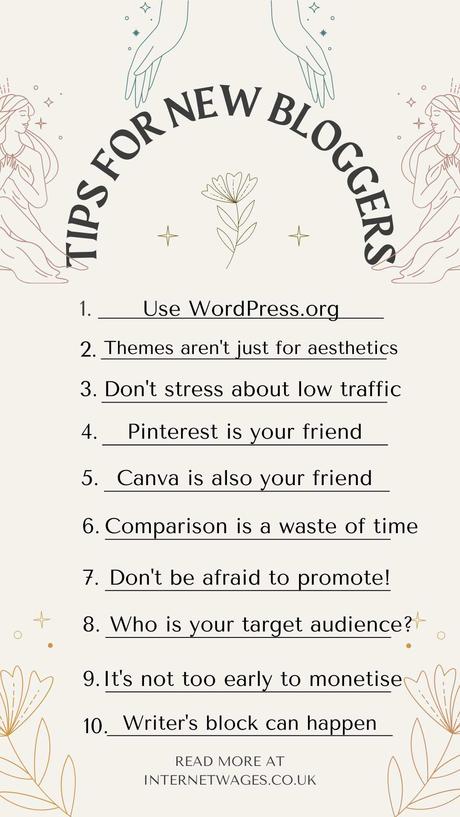 Save or pin this these tips for new bloggers to refer to later.
Save or pin this these tips for new bloggers to refer to later.
If you don’t feel like writing a blog post, there are always other blogging tasks you could work on, like scheduling social media posts or removing broken links. I like to go through my old content and improve it when the blank WordPress page is too intimidating for me!
I’ve got a post about 20 behind-the-scenes blogging tasks to do when you have blogger’s block, give that a read if you need some tips.
I didn’t intend for this post to be over 2000 words, but that just happens sometimes! If you’re a new blogger, or you’re considering starting a blog, best of luck to you. I hope that these tips for new bloggers help, and most importantly, that you enjoy your blogging journey.
All the best,
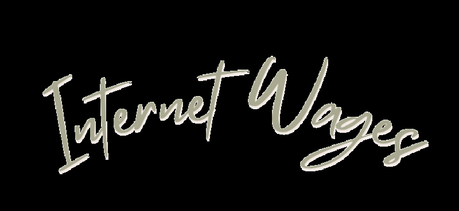
You may also like:
- 27 Free Writing Tools You Need To Try
- 20 Things To Do When You Don’t Feel Like Blogging
- What Does Blogging Success Look Like?
Pin 10 Tips For New Bloggers in 2021 For Later?
